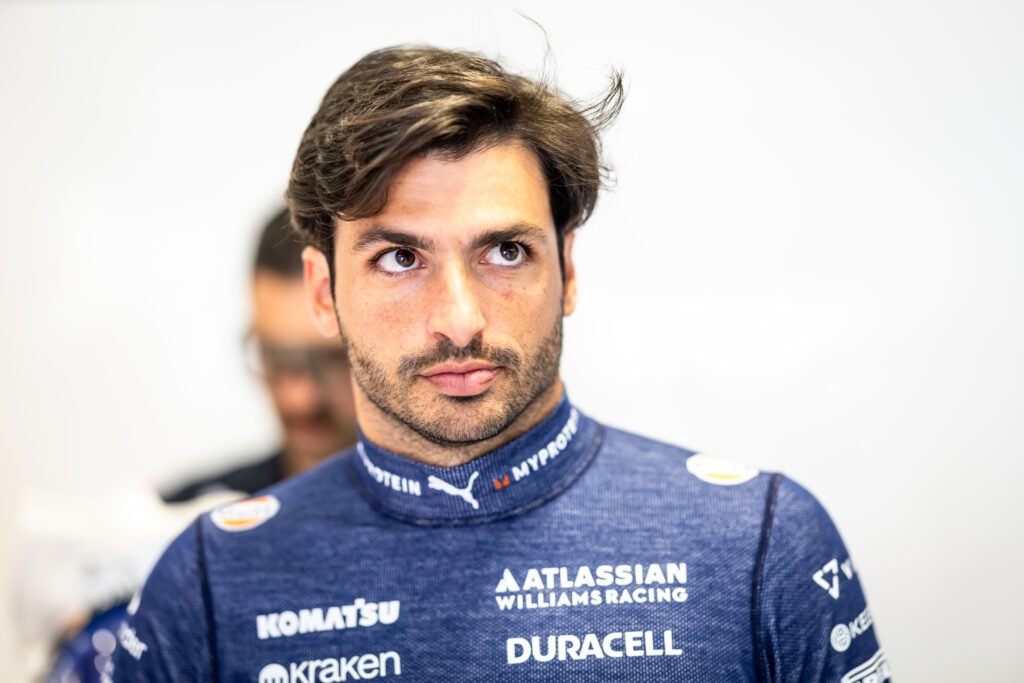Carlos Sainz left the Imola GP with a bitter taste, having crossed the line in eighth despite showing what he described as “top five” pace of his Williams. The Spaniard’s weekend, much like Williams’s overall performance, was marked by promise undone by poor strategic execution.
The Autodromo Internazionale Enzo e Dino Ferrari proved a complicated puzzle for many teams. The field grappled with the new C6 tyres and Imola’s ever-present overtaking difficulties. In the end, Max Verstappen claimed victory ahead of McLaren duo Lando Norris and Oscar Piastri, but it was Williams—and Sainz in particular—who were left reflecting on another missed opportunity at the Imola GP.
What went wrong for Sainz?
Sainz dropped back early in the race following a questionable call from the pit wall to bring him in earlier than most. The Spaniard spent much of the race recovering lost ground: He eventually climbed back to P8, a result that felt underwhelming given the car’s potential.
Speaking after the race, Sainz did not hide his disappointment.
“Obviously a bit unhappy right now after another weekend where we have a good pace, strong enough to score a top five today. We were quicker than Mercedes, quicker than Ferrari. I honestly felt really good out there through the whole weekend. But for some reason, we don’t seem to catch a break on Sundays.”
Williams’s early pit strategy raised eyebrows, with Sainz the first of the front-runners to switch tyres. While the team may have hoped to undercut rivals, the move ultimately backfired. Traffic and tyre degradation left Sainz vulnerable, and the early stop compromised the remainder of his race.
“With the race execution, we pitted really early, felt too early at the time. It obviously was too early in the end. We just need to keep making steps forward on understanding each other on Sundays, because at the moment, it’s costing us a lot of points on Sunday.”
Despite the frustration, the Spaniard remains optimistic. His qualifying performance and race pace show a driver in full command of his machinery. Even if the team around him still needs to fine-tune execution on race day to success.
“But if on race six I’m showing the level that I’m showing in terms of speed with the car and the way I feel, I know we can only go forward. So, I will remain positive and keep pushing each other to keep improving as a team.”
What does the Spaniard think about Williams’ strengths?
When asked about the team’s overall competitiveness and their ability to take the fight to traditional powerhouses like Ferrari and Mercedes, Sainz highlighted both the progress and the opportunity lost.
“Well, it’s strange because, again, if you would have told me a few races ago, even a year ago, that we would be fighting Mercedes and Ferrari on pure pace at these tracks and I would be upset with a P8, I would have been very unhappy.
“But right now the reality is that we had a car the last two weekends to beat them and we haven’t. And this obviously doesn’t make me very happy. Because I know we have the potential and the speed to beat these teams in these sort of tracks.”
The fightback from P15 to P8 was commendable. I was aided in part by late-race incidents and a safety car; but for Sainz, it shouldn’t have been necessary.
“But we don’t seem to execute well on Sundays. So, it just means as a team we need to improve, we need to keep making our understanding with each other a bit better to make sure on Sundays we don’t overcomplicate things.
“Today, I didn’t expect to have to fight back from P15 to P8, which made my life difficult, but we managed to do it.”
With another race where Williams showed signs of strong underlying performance but faltered when it mattered most, the road ahead is clear for Sainz and his team. Translate Saturday pace into Sunday results.
For a driver who knows what it takes to challenge at the sharp end, the sense of urgency is growing.



